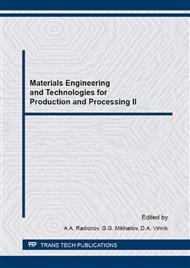[1]
L.B. Getsov, Materials and strengt of Gasturbinen elements, Book 1, Gasturbinen Technologies Publishing Inc., Rybinsk, (2010).
Google Scholar
[2]
G.A. Webster, S.R. Holdsworth, A Code of Practice for conducting notched bar creep tests and for interpreting the data, Fatigue FractEngng Mater Struct. 27 (2004) 319-342.
DOI: 10.1111/j.1460-2695.2004.00765.x
Google Scholar
[3]
M. Yatomi, N.P. O'Dowd, Modelling of damage development and failure in notched bar multiaxial creep tests, Fatigue FractEngng Mater Struct. 27 (2004) 283-295.
DOI: 10.1111/j.1460-2695.2004.00755.x
Google Scholar
[3]
G. Eggeler, C. Wiesner, A numerical study of parameters controlling stress redistribution in circular notched specimens during creep, Journal of strain analysis. 28 (1993) 13-22.
DOI: 10.1243/03093247v281013
Google Scholar
[4]
H. -T. Yao, F-Z. Xuan, A review of creep analysis and design under multi-axial stress states, Nuclear Engineering and Design. 237 (2007) 1969-(1986).
DOI: 10.1016/j.nucengdes.2007.02.003
Google Scholar
[5]
G. Eggeler, C. Wiesner, A numerical study of parameters controlling stress redistribution in circular notched specimens during creep, Journal of strain analysis. 28 (1993) 13-22.
DOI: 10.1243/03093247v281013
Google Scholar
[6]
V. Gaffard, Experimental study and modelling of high-temperature creep flow and damage behaviour of 9Cr1Mo-NbV steel weldments, Ph.D. diss., Paris, (2004).
DOI: 10.3184/096034008x356998
Google Scholar
[7]
Y. Gorash, Development of a creep-damage model for non-isothermal long-term strength analysis of high-temperature components operating in a wide stress range, Ph.D. diss., Halle, (2008).
Google Scholar
[8]
T.V. Prokhorova, T.R. Stepanova, Development of creep-damage model for P91 steel, Nauchno-technicheskie vedomosti SPbGPU seria: Fiziko-matematicheskie nauki. 4 (2011) 130-136.
Google Scholar
[9]
L. Esposito, N. Bonora, A primary creep model for Class M materials, Materials Science and Engineering. A528 (2011) 5496-5501.
DOI: 10.1016/j.msea.2011.03.069
Google Scholar
[11]
L. Kloc, V. Sklenichka, Importance of the loading history in creep of 9% Cr steel, Proc. of International Conference BALTICA VI Life Management and Maitenance for Power Plants, VTT Symposium 234, VTT, Espoo, Finland, 2004, pp.491-498.
Google Scholar
[12]
L. Kloc, Internal stress model for pre-primary stage of low-stress creep, J. Phys.: Conf. Ser. 240 (2010) 012086.
DOI: 10.1088/1742-6596/240/1/012086
Google Scholar
[13]
J.W. Hancock, A.C. Mackenzie, On the mechanisms of ductile failure in high-strength steels subjected to multi-axial stress-states, J. Mech. Phys. Solids. 24 (1976) 147-169.
DOI: 10.1016/0022-5096(76)90024-7
Google Scholar
[14]
S. Holmström, J. Rantala, Modeling and verification of creep strain and exhaustion in a welded steam mixer, Journal of Pressure Vessel Technology. 131 (2009) 061405.
DOI: 10.1115/1.4000201
Google Scholar
[15]
M.W. Spindler, R. Hales, R.A. Ainworth, Multiaxial Creep-Fatigue rules, Proceedings of a Technical Committee meeting on creep-fatigue damage rules for advanced fast reactor design, Manchester, United Kingdom. (1997) 87-96.
DOI: 10.1016/0029-5493(94)00832-j
Google Scholar
[16]
M.W. Spindler, The multiaxial creep ductility of austenitic stainless steels, Fatigue Fract Engng Mater Struct. 27(2004) 273-281.
DOI: 10.1111/j.1460-2695.2004.00732.x
Google Scholar


